One observation I have made as I drive through America is the poverty visible especially in the black community: half are speaking and yelling to themselves (schizophrenIa), a quarter are disabled and the rest destitute. I am panhandled every time I stop.
PENNSYLVANIA
Officially the Commonwealth of Pennsylvania, is a state located in the Northeastern, Great Lakes, Appalachian, and Mid-Atlantic regions. The Appalachian Mountains run through its middle. The Commonwealth is bordered by Delaware to the southeast, Maryland to the south, West Virginia to the southwest, Ohio to the west, Lake Erie and the Canadian province of Ontario to the northwest, New York to the north, and New Jersey to the east.
Pennsylvania is the 33rd-largest state by area, and the 5th-most populous state Pennsylvania’s two most populous cities are Philadelphia (1,580,863), and Pittsburgh (302,407). The state capital and its 10th-largest city is Harrisburg. Pennsylvania has 140 miles (225 km) of waterfront along Lake Erie and the Delaware River.
The state is one of the 13 original founding states of the United States; it came into being in 1681 as a result of a royal land grant to William Penn, the son of the state’s namesake. Part of Pennsylvania (along the Delaware River), together with the present State of Delaware, had earlier been organized as the Colony of New Sweden. Independence Hall, where the United States Declaration of Independence and United States Constitution were drafted, is located in Philadelphia. During the American Civil War, the Battle of Gettysburg was fought in the south central region of the state. Valley Forge near Philadelphia was General Washington’s headquarters during the bitter winter of 1777–78.
Philadelphia in the southeast corner, Pittsburgh in the southwest corner, Erie in the northwest corner, Scranton-Wilkes-Barre in the northeast corner, and Allentown-Bethlehem-Easton in the east central region are urban manufacturing centers. Much of the Commonwealth is rural; this dichotomy affects state politics as well as the state economy.Philadelphia is home to six Fortune 500 companies, with more located in suburbs like King of Prussia; it is a leader in the financial and insurance industry.
Pittsburgh is home to eight Fortune 500 companies, including U.S. Steel, PPG Industries, and H.J. Heinz. Hershey is home to The Hershey Company, one of the largest chocolate manufacturers in the world. Erie is also home to GE Transportation, which is the largest producer of train locomotives in the United States.
PHILADELPHIA (pop 1,585,000)
Known colloquially as Philly, it is the sixth-most populous U.S. city. Philadelphia is the economic and cultural anchor of the greater Delaware Valley. The Delaware Valley’s has a population of 7.2 million.
Philadelphia is one of the oldest municipalities in the United States. William Penn, an English Quaker, founded the city in 1682 to serve as capital of the Pennsylvania Colony. Philadelphia played an instrumental role in the American Revolution as a meeting place for the Founding Fathers of the United States, who signed the Declaration of Independence in 1776 at the Second Continental Congress, and the Constitution at the Philadelphia Convention of 1787. Several other key events occurred in Philadelphia during the Revolutionary War including the First Continental Congress, the preservation of the Liberty Bell, the Battle of Germantown, and the Siege of Fort Mifflin. Philadelphia remained the nation’s largest city until being overtaken by New York City in 1790; the city was also one of the nation’s capitals during the revolution, serving as temporary U.S. capital while Washington, D.C. was under construction. In the 19th century, Philadelphia became a major industrial center and a railroad hub. The city grew from an influx of European immigrants, most of whom came from Ireland, Italy and Germany—the three largest reported ancestry groups in the city as of 2015. In the early 20th century, Philadelphia became a prime destination for African Americans during the Great Migration after the Civil War, as well as Puerto Ricans. The city’s population doubled from one million to two million people between 1890 and 1950.
Its many universities and colleges make it a top study destination. Philadelphia has more outdoor sculptures and murals than any other American city. The city is known for its arts, culture, cuisine, and colonial history, attracting 42 million domestic tourists in 2016 who spent $6.8 billion,
Philadelphia is the birthplace of the United States Marine Corps, and is also the home of many U.S. firsts, including the first library (1731), hospital (1751), medical school (1765), national capital (1774), stock exchange (1790), zoo (1874), and business school (1881). Philadelphia contains 67 National Historic Landmarks and the World Heritage Site of Independence Hall. Although Philadelphia is rapidly undergoing gentrification, the city actively maintains strategies to minimize displacement of homeowners in gentrifying neighborhoods.
Independence Hall is the building where both the United States Declaration of Independence and the United States Constitution were debated and adopted. It is now the centrepiece of the Independence National Historical Park and is listed as a World Heritage Site.[3]
The building was completed in 1753 as the Pennsylvania State House, and served as the capitol for the Province and Commonwealth of Pennsylvania until the state capital moved to Lancaster in 1799. It became the principal meeting place of the Second Continental Congress from 1775 to 1783 and was the site of the Constitutional Convention in the summer of 1787.
Architecture. Independence Hall touts a red brick facade, designed in Georgian style. It consists of a central building with bell tower and steeple, attached to two smaller wings via arcaded hyphens. The highest point to the tip of the steeple spire is 168 ft, 71⁄4 inches above the ground.
While the shell of the central portion of the building is original, the side wings, steeple and much of the interior were reconstructed. In 1781, the steeple had rotted and a more elaborate steeple was added in 1828. The original wings and hyphens were demolished and replaced in 1812. In 1898, these were in turn demolished and replaced with reconstructions of the original wings. The current interior is a mid-20th-century reconstruction by the National Park Service with the public rooms restored to their 18th-century appearance.
Two smaller buildings adjoin the wings of Independence Hall: Old City Hall to the east, and Congress Hall to the west. These three buildings are together on a city block known as Independence Square. Since its construction in the mid-20th century, to the north has been Independence Mall, which includes the current home of the Liberty Bell.
Liberty Bell. The lowest chamber of the original wooden steeple was the first home of the Liberty Bell. When that steeple was removed in the 1780s the bell was lowered into the highest chamber of the brick tower, where it remained until the 1850s. The much larger Centennial Bell, created for the United States Centennial Exposition in 1876, hangs in the cupola of the 1828 steeple. The Liberty Bell, with its distinctive crack, was displayed on the ground floor of the hall from the 1850s until 1976, and is now on display across the street in the Liberty Bell Center.
Second Continental Congress. From May 10, 1775, to 1783, the Pennsylvania State House served as the principal meeting place of the Second Continental Congress, a body of representatives from each of the thirteen British North American colonies. They nominated George Washington as commander-in-chief of the Continental Army and Benjamin Franklin to be the first Postmaster General.
Declaration of Independence was approved there on July 4, 1776. This document unified the colonies in North America who declared themselves independent of the Kingdom of Great Britain and explained their justifications for doing so.
Lincoln’s Funeral Train. His body was carried by hearse past a crowd of 85,000 people. Over 300,000 mourners viewed the body.
In 1915, the League to Enforce Peace was formed here, an international governing body under which participating nations would commit to “jointly…use…their economic and military forces against any one of their number making war against another” and “to formulate and codify rules of international law”.
Independence Hall is pictured on the back of the U.S. $100 bill, as well as the bicentennial Kennedy half dollar. The Assembly Room is pictured on the reverse of the U.S. two-dollar bill.

Philadelphia 30th Street Station is an intermodal transit station: the metropolitan area’s main railroad station (a major stop on Amtrak’s Northeast and Keystone corridors) doubles as a major commuter rail station and is also served by several SEPTA city and suburban buses, as well as buses operated by NJ Transit and intercity operators.
The station, which served more than 4 million inter-city rail passengers in 2018, is Amtrak’s third-busiest, after Penn Station in Manhattan and Union Station in Washington, D.C., and the nation’s 12th-busiest train station overall.
The station opened in 1933. The vast waiting room is faced with travertine and the coffered ceiling is painted gold, red and cream. The building’s exterior has columned porte-cocheres on the west and east facade, and shows a balance between classical and modern architectural style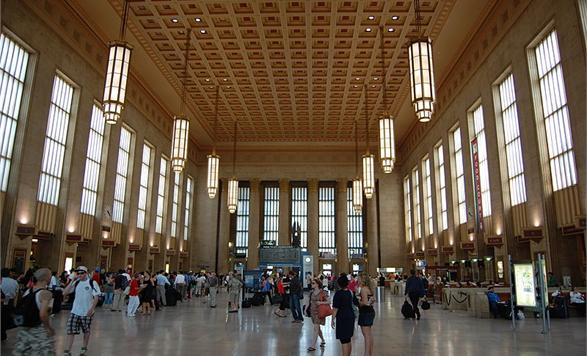
The following 5 sights are in the NM “Modern Architecture Buildings” series:
Philadelphia City Hall is the world’s largest free standing masonry building made of brick, white marble, limestone and granite and functions as the seat of government for the city of Philadelphia. Constructed from 1871 to 1901. Upon completion of its tower in 1894, and at 548 ft (167 m) it became the world’s tallest habitable building. It was also the first secular building to have this distinction, as all previous world’s tallest buildings were religious structures, including European cathedrals and—for the previous 3,800 years—the Great Pyramid of Giza.
It contains 700 rooms, the largest municipal building in the United States and one of the largest in the world and used over 88 million bricks and thousands of tons of marble and granite. The tower features a clock face on each side that is 26 ft (7.9 m) in diameter. The observation deck is located directly below the base of the statue, about 500 ft (150 m) above street level reached in a 6-person elevator The building is topped by a 37 ft bronze statue weighing 53,348 lb of city founder William Penn, one of 250 sculptures created by Alexander Milne Calder that adorn the building inside and out. The statue is the tallest atop any building in the world.
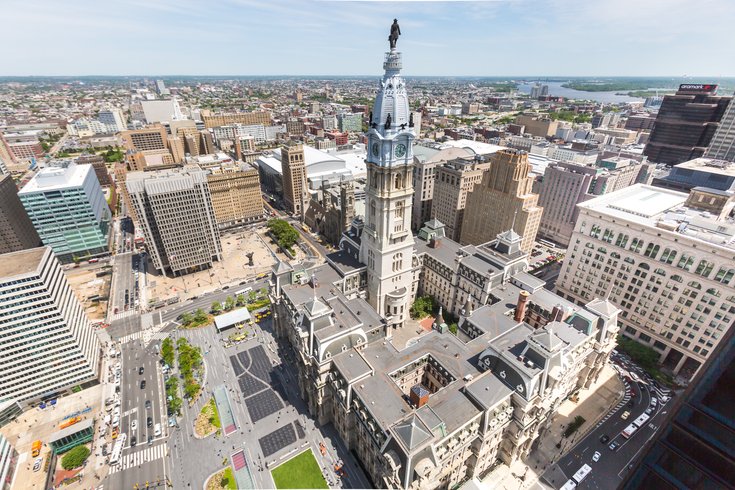
Richards Medical Research Laboratories. Located on the campus of the University of Pennsylvania in Philadelphia, were designed by architect Louis Kahn and are considered to have been a breakthrough in his career. The building is configured as a group of laboratory towers with a central service tower. Brick shafts on the periphery hold stairwells and air ducts, producing an effect reminiscent of the ancient Italian towers that Kahn had painted several years earlier.
Rather than being supported by a hidden steel frame, the building has a structure of reinforced concrete that is clearly visible and openly depicted as bearing weight. Built with precisely-formed prefabricated concrete elements, the techniques used in its construction advanced the state of the art for reinforced concrete.
Despite observable shortcomings, this building helped set new directions for modern architecture with its clear expression of served and servant spaces and its evocation of the architecture of the past.

The Bellevue Hotel. Constructed in 1904 costing over $8million (in 1904$), it was described at the time as the most luxurious hotel in the nation and perhaps the most spectacular hotel building in the world. It had hundreds of guest suites in a variety of styles, the most magnificent ballroom in the United States, delicate lighting fixtures designed by Thomas Edison, stained and leaded glass embellishments in the form of transoms and Venetian windows and sky-lights by Alfred Godwin, and the most celebrated marble and hand-worked iron elliptical staircase in the city. In 1912 a large 9-story extension increased it to a reputed 1,090 guest rooms, and added the top floor domed function rooms.
During the 1940s and 1950s, the classic architecture and rich decorative details of the hotel were thought to be overpowering, anachronistic and even offensive.
The hotel gained worldwide notoriety in July 1976, when it hosted a statewide convention of the American Legion. Soon after, a pneumonia-like disease killed 29 people and sickened 182 more who had been in the hotel. The negative publicity associated with what became known as “Legionnaires’ Disease” caused occupancy at the Bellevue-Stratford to plummet to 4 percent and the hotel finally closed in 1976. The new bacterium thrives in hot, damp places like the water of the cooling towers for the Bellevue-Stratford’s air-conditioning system, which spread the disease throughout the hotel. The bacterium was named Legionella and the disease, legionellosis, after the first victims.
It was sold in 1978 and had a $25-million restoration. The guest rooms were completely gutted and their number reduced from 725 to 565, while the public areas were painstakingly restored to their 1904 appearance. 44,000 square yards of carpet were imported from Ireland, 25 tons of marble came from Portugal and crystal chandeliers were sourced from Uruguay.
In another extensive $100 million renovation, the ground floor were converted to retail space. The hotel rooms on floors 3 to 11 were converted into office space, and the hotel portion was condensed to 170 guest rooms on floors 12-18 owned by Hyatt.
PSFS Building. Now the Loews Philadelphia Hotel, the building was the first International style skyscraper constructed in the United States. Built for the Philadelphia Saving (later Savings) Fund Society in 1932, it lacked features such as domes and ornamentation. The building featured an innovative T-shaped tower that allowed the maximum amount of natural light and rentable space. Office tenants were attracted by modern facilities such as radio receivers, and the second high-rise in the U.S. to be equipped with air conditioning. The skyscraper is topped by a red neon sign with the Philadelphia Saving Fund Society’s initials (PSFS) on it. Visible for 20 miles (32 km), the sign has become a Philadelphia icon.
Reading Terminal Market. This busy downtown market has a wide variety of American food (cheese steak) ethnic food, fresh vegys, meat and sea food.
AKA Rittenhouse Hotel. Across from Rittenhouse Square, the jewel of William Penn’s plan for Philadelphia, it was built in 1912, this historic landmark has been transformed with 78 elegantly-furnished suites with full kitchens, stylish contemporary interiors, while preserving the building’s magnificent Beaux-Arts façade. It provides luxury extended accommodations for short- and long-term stays.
Break Through Your Mold Sculpture (Freedom Sculpture). In the NM “Bizzarium” series, it is instantly recognized that it is about the idea of struggling to break free. Almost everyone has the need to escape from some situation—be it an internal struggle or an adversarial circumstance, and to be free from it. 20 feet long x 8 feet high, the bronze 7,000 pounds sculpture by Zenos Frudakis was dedicated in 2001.
Although there are four figures represented, the work is really one figure moving from left to right beginning with a kind of mummy/death like captive figure locked into its background. The second figure begins to stir and struggle to escape. The third has torn himself from the wall and is stepping out, reaching for freedom and the fourth is entirely free, victorious, arms outstretched, completely away from the wall and from the grave space he left behind.
There are several other elements: a cast of the sculptor’s hand holding the sculpture tool, his fingerprints are all over the sculpture, calipers, an anatomical man and his cat, mother, father, and self portrait are in the work.  Guild House is a residential building, an important and influential work of 20th-century architecture and was the first major work by Robert Venturi. Along with the Vanna Venturi House it is considered to be one of the earliest expressions of Postmodern architecture, and helped establish Venturi as one of the leading architects of the 20th century.
Guild House is a residential building, an important and influential work of 20th-century architecture and was the first major work by Robert Venturi. Along with the Vanna Venturi House it is considered to be one of the earliest expressions of Postmodern architecture, and helped establish Venturi as one of the leading architects of the 20th century.
The 6-story building, which houses 91 apartments for low-income senior citizens, was commissioned by a local Quaker organization, Friends Rehabilitation Program, Inc. and completed in 1963. The exterior is red clay brick and “inelegant” double-hung windows. The stepped organization of the facade allowed most of the units to have south-, east-, or west-facing windows, giving the inhabitants sunlight and a view of the street below. Winding interior corridors were intended to create a more intimate and informal space.
Eastern State Penitentiary. In the NM “The Dark Side” series, this former prison was operational from 1829 until 1971. The penitentiary refined the revolutionary system of separate incarceration which emphasized principles of reform rather than punishment.
Notorious criminals such as Al Capone and bank robber Willie Sutton were held inside its innovative wagon wheel design. At its completion, the building was the largest and most expensive public structure ever erected in the United States, and quickly became a model for more than 300 prisons worldwide.
Considered to be the world’s first true penitentiary. Eastern State’s radial floor plan and revolutionary system of incarceration, dubbed the “Pennsylvania system” or separate system, encouraged separate confinement as a form of rehabilitation. The warden was legally required to visit every inmate every day, and the overseers were mandated to see each inmate three times a day. It was opposed contemporaneously by the New York system where prisoners were forced to work together in silence, and could be subjected to physical punishment.
Outside the cell was an individual area for exercise, enclosed by high walls so prisoners could not communicate. Exercise time was synchronized so no two prisoners next to each other would be out at the same time. Prisoners were allowed to garden and even keep pets in their exercise yards. When a prisoner left his cell, an accompanying guard would wrap a hood over his head to prevent him from being recognized by other prisoners.
Cell accommodations were advanced for their time, including a faucet with running water over a flush toilet, as well as curved pipes along part of one wall which served as central heating during the winter months where hot water would be run through the pipes to keep the cells reasonably heated. Toilets were remotely flushed twice a week by the guards of the cellblock.
Inmates were punished with the “individual-treatment system.” At the time this form of punishment was thought to be most effective. They would be separated from others.
On April 3, 1945, a major escape was carried out by twelve inmates (including the infamous Willie Sutton), who over the course of a year managed to dig an undiscovered 97-foot (30 m) tunnel under the prison wall. During renovations in the 1930s an additional 30 incomplete inmate-dug tunnels were discovered.
The prison was closed in 1971. During the abandoned era (until the late 80s) a “forest” grew in the cell blocks and outside within the walls. The prison also became home to many stray cats. In 1994, Eastern State opened to the public for history tours.
The solitary confinement system eventually collapsed due to overcrowding problems by 1913, Proponents of the system believed strongly that the criminals, exposed, in silence, to thoughts of their behavior and the ugliness of their crimes, would become genuinely penitent. In reality, the facility designed a variety of physical and psychological torture regimens for various infractions, including dousing prisoners in freezing water outside during winter months, chaining their tongues to their wrists in a fashion such that struggling against the chains could cause the tongue to tear, strapping prisoners into chairs with tight leather restraints for days on end, and putting the worst behaved prisoners into a pit called “The Hole”, an underground cellblock dug under cellblock 14 where they would have no light, no human contact, and little food for as long as two weeks. Prior to its closing in late 1969, it had established a far reaching program of group therapy with the goal of having all inmates involved. 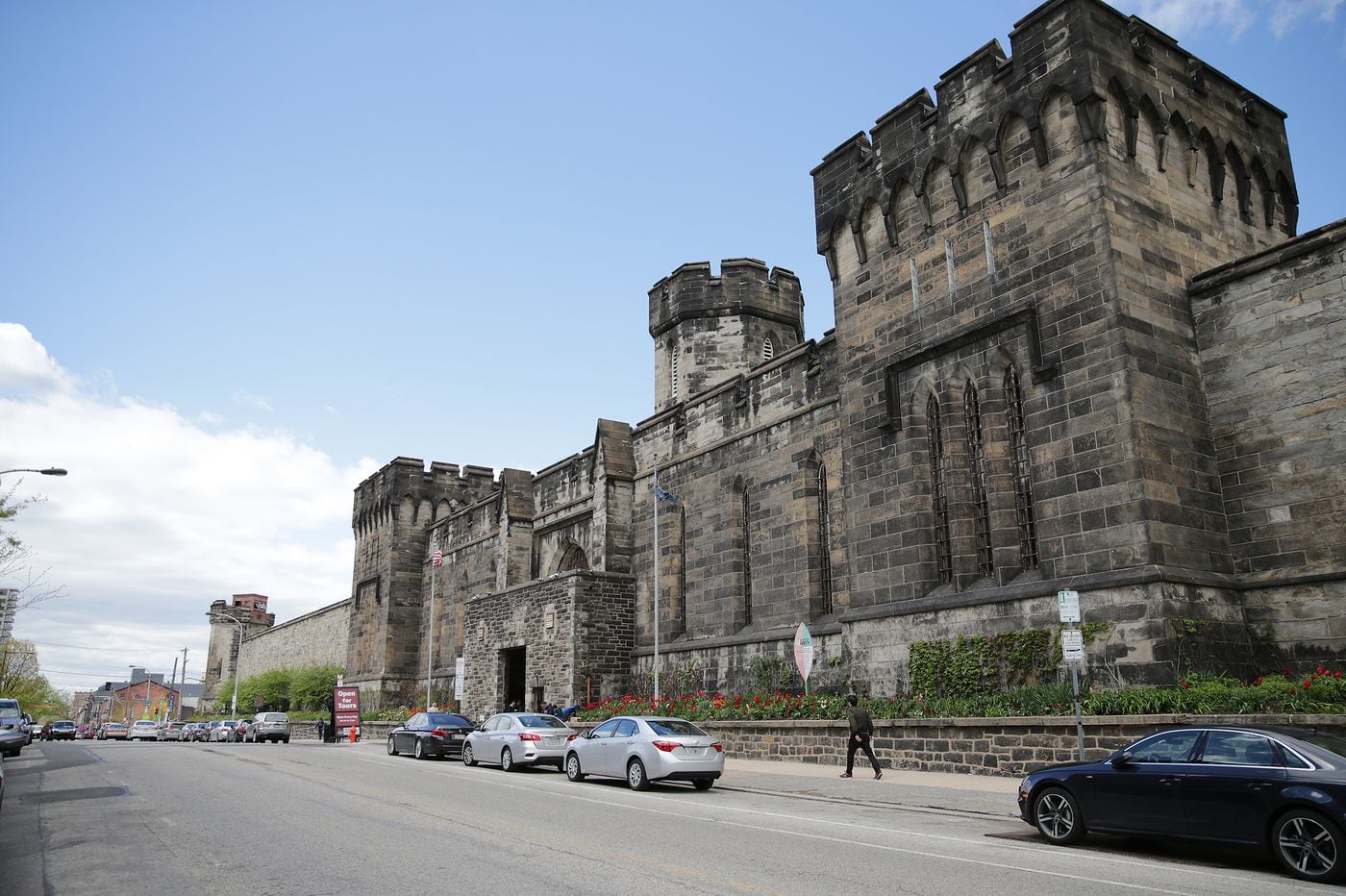 Vanna Venturi House. One of the first prominent works of the postmodern architecture movement, it was designed by architect Robert Venturi for his mother, Vanna Venturi, and constructed between 1962 and 1964.
Vanna Venturi House. One of the first prominent works of the postmodern architecture movement, it was designed by architect Robert Venturi for his mother, Vanna Venturi, and constructed between 1962 and 1964.
The five-room house is 30 feet tall at the top of the chimney, but has a monumental front facade, called the biggest small building of the second half of the twentieth century.
As a widow nearing the age of 70 as the house was completed, Vanna required that all her daily routine could be conducted on one floor: the master bedroom, a full bathroom, the caretaker’s room, the kitchen and a living/dining area. Her son, the architect, occupied the second floor, which contains a bedroom/studio with a large lunette window, a private balcony, and a half-bath on the stair landing. Vanna Venturi lived in the house from 1964 though 1973 and died in 1975.
Many of the basic elements of the house are a reaction against standard Modernist architectural elements: the pitched roof rather than flat roof, the emphasis on the central hearth and chimney, a closed ground floor “set firmly on the ground” rather than the Modernist columns and glass walls which open up the ground floor. Unusually, the gable is placed on the long side of the rectangle formed by the house, and there is no matching gable at the rear.
Chestnut Hill is a residential neighborhood located in the northwestern part of Philadelphia. It was first settled in the early eighteenth century and still has many stone buildings from that period.
Awards: the prestigious Twenty-five Year Award by the American Institute of Architects; Pritzker Architecture Prize for work that “has produced consistent and significant contributions to humanity … through the art of architecture; 2005, The United States Postal Service featured the house on a postage stamp in a series of “Twelve masterworks of modern American architecture.” In 2012 the Vanna Venturi House was awarded the 2012 AIA Philadelphia Landmark Building Award. 
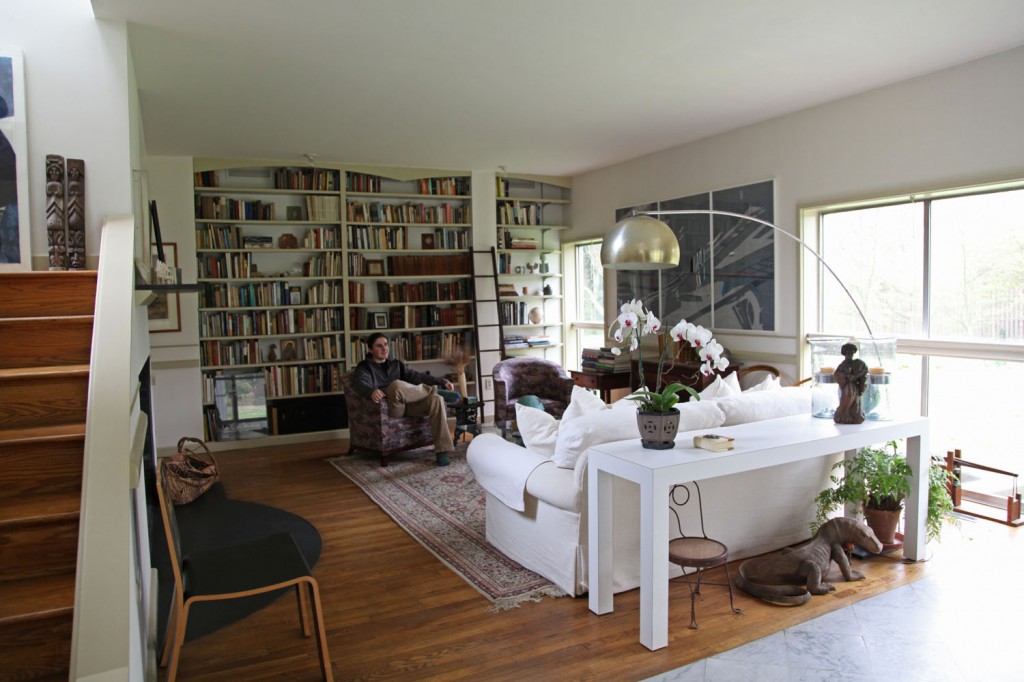
Fortunately, the son of the owner walked by and allowed me to walk around the house.
King of Prussia is the second largest shopping mall in the United States. It is an upscale mall with numerous retailers, anchored by Lord & Taylor, Dick’s Sporting Goods, Primark, Neiman Marcus, Nordstrom, Macy’s and Bloomingdale’s with one vacant anchor last occupied by JCPenney. The mall is located in King of Prussia, northwest of the city of Philadelphia. The mall, which opened in 1963, consisted of two distinct buildings known as The Plaza and The Court until August 2016, when a major expansion was completed and the two buildings were finally connected to create one massive shopping mall.
Bryn Athyn Cathedral, Bryn Athyn. It is the episcopal seat of The General Church of the New Jerusalem, a denomination of Swedenborgianism. The main building is of the Early Gothic style, while the adjoining structures are of a transitional period reflective of a combination of both Gothic and Norman styles. Bryn Athyn is also the site of the General Church affiliated Academy of the New Church, which publishes Swedenborgian literature, and is the parent organization of a high school, a four-year college (Bryn Athyn College of the New Church), a theological school, and the Emanuel Swedenborg Library.
The Cathedral was constructed from 1913-1919. The stained glass windows use the medieval method of creating stained glass, namely of melting various pigment and metallic oxides into the glass itself and then having a glass blower create a disk of glass with varying degrees of thickness and brightness. All the windows themselves were not completed till the 1960s.
Right next to the college, the library and the cathedral is the Academy-affiliated Glencairn Museum. Originally the private residence of Raymond Pitcairn, this castle-like building now houses a collection of mostly religious artwork from around the world and is open to the public.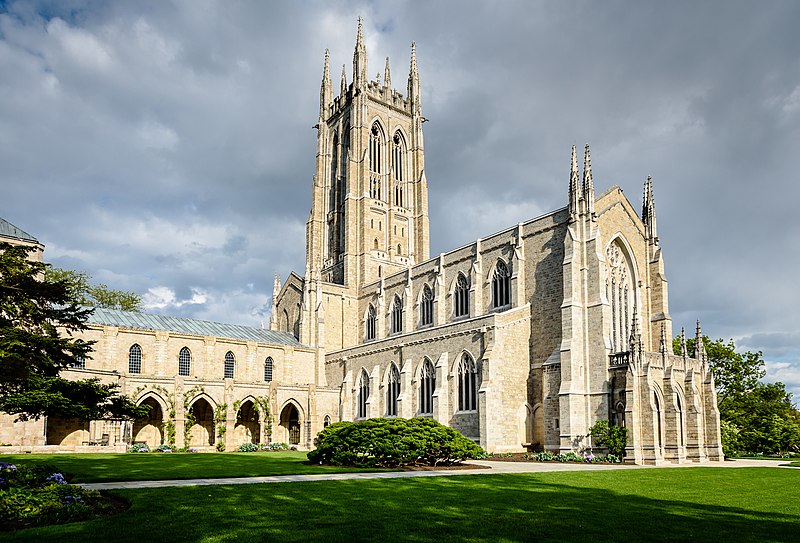
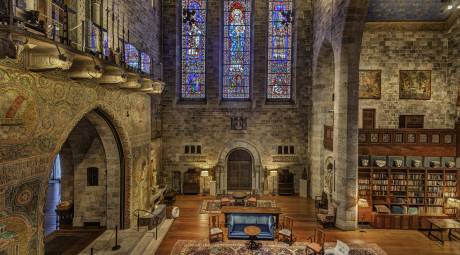
Fonthill Castle, Doylestown. This was the home of the archaeologist and tile maker Henry Chapman Mercer. Built between 1908 and 1912, it is an early example of poured-in-place concrete and features 44 rooms, over 200 windows, 18 fireplaces, 10 bathrooms and one powder room. The castle contains built-in furniture and is embellished with decorative tiles, made by Mercer at the height of the Arts and Crafts movement. The castle is filled with an extensive collection of ceramics embedded in the concrete of the house, as well as other artifacts from his world travels, including cuneiform tablets discovered in Mesopotamia dating back to over 2300 BCE. The home also contains around 1,000 prints from Mercer’s extensive collection, as well as over six thousand books, almost all of which were annotated by Mercer himself.
Volendam Windmill is a smock mill located on Adamic Hill Road in Holland Township, New Jersey. The windmill was designed and built in 1965 as a working mill driven by wind, used for grinding raw grain into flour. The 60-foot structure is seven stories high with sail arms 68 feet from tip to tip. As of November 2010, the county’s website shows that the museum is closed.
BETHLEHEM
Moravian Church Settlements.
Historic Moravian Bethlehem constitutes approximately 14 acres in the heart of the city. It was here in 1741 at the confluence of the Monocacy Creek and Lehigh River that the first Moravians. The Moravians eventually acquired close to 4,000 acres in Bethlehem. Bethlehem was to be the principal center for Moravians in the New World. From here, they sent missionaries throughout the American colonies and to the West Indies.
The Moravians in Bethlehem lived in a communal society organized into groups, called choirs, by age, sex, and marital status. Everyone worked for the good of the community and received care from cradle to grave. Based on their societal organization, the community developed large institutional choir houses, superb examples of colonial Germanic-style architecture in America.
By 1747, thirty-five crafts, trades and industries were established including a butchery, tawery, clockmaker, tinsmith, nailor, pewterer, hatter, spinning, weaving, cooper, dye house, community bakery, candlemaker, linen bleachery, fulling mill, saddlery, tailor, cobbler, flax processing, wheelwright, carpenter, mason. As the community developed and needed greater output, they replaced the log buildings with larger limestone buildings. The pottery, tannery, butchery, dye house, smith complex, oil mill, and waterworks were built of stone in the period from the late 1740s through the early 1770s.
Moravian buildings, many still standing today, reflect the ingenuity, creativity, and universality of Moravian thinking and philosophy. The Moravians believed that all people, both men and women, should receive the same education; that all people should receive health care; that women should have equal rights with men in the community; and that all people should work together for the good of the community without prejudice regarding race, gender, or ethnicity. At one time in the mid-18th century, 15 different languages were spoken in Bethlehem.
Historic Moravian Bethlehem has a high degree of both integrity and authenticity and encompasses excellent examples of the architecture and town planning of the 18th century community.
History. The Moravian Church in North America is part of the worldwide Moravian Church Unity. It dates from the arrival of the first Moravian missionaries to the United States in 1735, from their Herrnhut settlement in present-day Saxony, Germany. They came to minister to the scattered German immigrants, to the Native Americans and to enslaved Africans. They founded communities to serve as home bases for these missions. The missionary “messengers” were financially supported by the work of the “laborers” in these settlements. Currently, there are more than 60,000 members.
The first Moravians to come to North America were August Gottlieb Spangenberg and Wenzel Neisser, who accompanied a group of persecuted Schwenkfelders to Pennsylvania in 1735 at Zinzendorf’s direction. The first, and unsuccessful, attempt to found a Moravian community in North America was in Savannah Georgia that also began in 1735; it collapsed because of internal discord, and government pressure for Moravians to serve in the militia in defense against Spanish raids from Florida (1740, the so-called “War of Jenkins’ Ear”).
The beginning of the church’s work in North America is usually given as 1740, when Christian Henry Rauch to New York City on a mission to preach and convert native peoples but were expelled in 1744.
The Moravians were more successful in Pennsylvania, where the charter of the colony provided religious freedom. The towns of Bethlehem, Nazareth, Emmaus, and Lititz, Pennsylvania, were founded along with Graceham, Maryland and Wachovia in Maryland (Bethabara (1753), Bethania (1759) and Salem (now Winston-Salem) (1766).
Winston-Salem became the headquarters of the southern church. The Moravian denomination continues in America to this day, with congregations in 18 states. The highest concentrations of Moravians exist in Bethlehem and Winston-Salem.
The Moravian emphasis on openness and tolerance, combined with the conversion experience of new birth, undermined ethnic homogeneity and provided a source of communal cohesion. The primary intermingling and intermarriage was between Germans and English.
Moravians’ beliefs centered on a feminized Holy Spirit, the right of women to preach, sacralizing the sex act, and metaphorically re-gendering Jesus Christ. These teachings were perceived as threats to more mainstream Christian articles of faith. Moravians welcomed anyone into their church services and they were perceived as a serious religious and social threat. Moravians valued work highly.
Architecture. A Moravian architecture style has emerged in the United States, predominately in Winston-Salem (Old Salem). Some Moravian churches in the area feature copper steeple tops which have oxidized and reached a green patina. The Moravian “Bonnet” or “eyebrow” arch is also an example of the style and is mainly used over building entrances, it is an unsupported half cylinder. Combined Moravian arches were used to form the dome of the Wachovia Center (now called 100 North Main Street).
There are diverse views regarding social issues in the denomination. The Moravian Church Northern Province has voted in favor of opening up ordination to gay and lesbian ministers, permits religious ceremonies for same-sex couples, and supports the right to abortion for certain situation.
Historic Hotel Bethlehem. The predecessor was the Moravian’s “Golden Eagle Hotel” dating from 1794 to 1919. It is 7- stories. 
Harrisburg (pop 50,000). The capital city of Pennsylvania, it lies on the east bank of the Susquehanna River, 107 miles (172 km) west of Philadelphia. During part of the 19th century, the building of the Pennsylvania Canal and later the Pennsylvania Railroad allowed Harrisburg to become one of the most industrialized cities in the Northeastern United States. In the mid-to-late 20th century, the city’s economic fortunes fluctuated with its major industries consisting of government, heavy manufacturing, agriculture, and food services (nearby Hershey is just 10 miles east.
The Pennsylvania Farm Show, the largest free indoor agriculture exposition in the United States, was first held in Harrisburg in 1917 and has been held there every early-to-mid January since then. Harrisburg is also known for the Three Mile Island accident, which occurred on March 28, 1979, near Middletown. The financial stability of the region is in part due to the high concentration of state and federal government agencies.
Broad Street Market. This small and old-fashioned lies in a poor area of Harrisburg. It primarily are food outlets.
NOMAD MANIA United States – Pennsylvania East (Philadelphia, Harrisburg, Scranton)
World Heritage Sites: Independence Hall
Tentative WHS: Moravian Church Settlements|
Museums
Chadds Ford: Brandywine River Museum of Art
Columbia: National Watch and Clock Museum
Easton: Crayola Experience
Ephrata: Ephrata Cloister
Oaks: American Treasure Tour
Williamsport: Arthaus Projects
House Museums/Plantations
Birdsboro: Daniel Boone Homestead
Northumberland: Joseph Priestley House
Castles, Palaces, Forts
Doylestown: Fonthill Castle
Morrisville: Pennsbury Manor
Religious Temples: Bryn Athyn: Bryn Athyn Cathedral
Botanical Gardens: Longwood: Longwood Gardens
Theme Parks
Elysburg: Knoebels Amusement Resort
Hershey: Hersheypark
Shartlesville: Roadside America
Open-Air Museums
Ephrata: Ephrata Cloister
Weatherly: Eckley Miners Village and Museum
Aviation Museums
Horsham: Wings of Freedom Aviation Museum
West Chester: American Helicopter Museum
Railway Museums: Strasburg: Railroad Museum of Pennsylvania
The Dark Side: Centralia
Cities of the Americas
ALLENTOWN
Airports: Allentown (ABE)
Museums
Allentown Art Museum
Da Vinci Science Center
The Alternative Gallery
PHILADELPHIA World Cities and Popular Towns
World Heritage Sites: Independence Hall
Airports: Philadelphia (PHL)
Railway, Metro, Funiculars, Cable Cars
Philadelphia 30th Street Station
Philadelphia: SEPTA and PATCO
Museums
Barnes Foundation of Philadelphia
Franklin Institute
Mutter Museum
National Museum of American Jewish History
Philadelphia Museum of Art
Please Touch Museum
Rodin Museum
House Museums/Plantations: Betsy Ross House
Modern Architecture Buildings
Philadelphia City Hall
Guild House
PSFS Building
Richards Medical Research Laboratories
Vanna Venturi House
Zoos: Philadelphia: Philadelphia Zoo
Malls/Department Stores
King of Prussia
Hospitality Legends
AKA Rittenhouse Hotel
The Bellevue Hotel
Markets: Reading Terminal Market
Vehicle Museums: Simeone Foundation Automotive Museum
The Dark Side: Eastern State Penitentiary
Bizzarium: Break Through Your Mold Sculpture
HARRISBURG*
Airports: Harrisburg (MDT)
Muesems:
National Civil War Museum
Pennsylvania National Fire Museum
State Museum of Pennsylvania
Susquehanna Art Museum
Whitaker Center for Science and the Arts
Markets: Broad Street Market
Villages and Small Towns
JIM THORPE
BETHLEHEM
Tentative WHS: Moravian Church Settlements
Museums
Kemerer Museum of Decorative Arts
Lehigh University Art Galleries
Hospitality Legends: Historic Hotel Bethlehem
GETTYSBURG*
Museums
Gettysburg Dime Museum
Gettysburg Museum of History
Ronn Palm’s Museum of Civil War
Open-Air Museum: Gettysburg National Military Park
HERSHEY*
Museums: The Hershey Story Museum
Vehicle Museums: Hershey: AACA Museum Inc.
SCRANTON
Museums:
Anthracite Heritage Museum
Everhart Museum
Railway Museums: National Historic Site
+++++++++++++++++++++++++++++++++++++++++++++++++++++++++++++
PENNSYLAVANIA WEST (Pittsburgh, Altoona, Erie)
Flight 93 National Memorial is located at the site of the crash of United Airlines Flight 93, which was hijacked in the September 11 attacks. The memorial was made to honor the passengers and crew of Flight 93, who stopped the terrorists from reaching their target by fighting the hijackers. The permanent memorial was completed, opened, and dedicated on September 10, 2011.
Of the four aircraft hijacked on September 11, Flight 93 is the only one that did not reach its intended target, presumed to be the United States Capitol in Washington, D.C. Several passengers and crew members made cellular telephone calls aboard the flight and learned about the attacks on the World Trade Center in New York City and the Pentagon. As a result, the passengers and crew members decided to mount an assault against the hijackers and wrest control of the aircraft. The plane crashed in a field in Stonycreek Township, Pennsylvania, about 150 miles (240 km) northwest of Washington, D.C., killing all 39 civilians, a U.S. Fish and Wildlife Service officer, two U.S. Bureau of the Census employees and four terrorists aboard.
The cost of the permanent memorial is estimated at $60 million. In 2017, construction of a 93 ft (28 m)-tall monumental “Tower of Voices” began. The tower contains 40 wind chimes — one for each passenger and crew member who died in the crash. The largest such structure ever built, the precast concrete tower supports polished aluminum chimes varying in length from 5 feet (1.5 m) to 10 feet (3.0 m) and varying tonalities, or voice.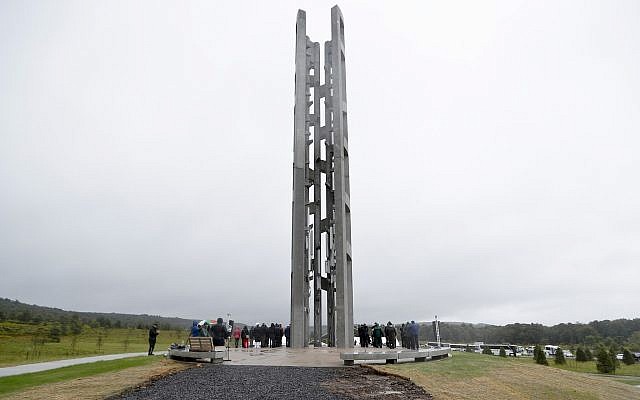
Frank Lloyd Wright Buildings. Eight of Wright’s buildings – Fallingwater, the Guggenheim Museum, the Hollyhock House, the Jacobs House, the Robie House, Taliesin, Taliesin West, and the Unity Temple – were inscribed on the list of UNESCO World Heritage Sites.
Fallingwater. Built in 1935 43 miles (69 km) southeast of Pittsburgh, the house was built partly over a waterfall on Bear Run. The house was designed as a weekend home for the family of Liliane Kaufmann and her husband, Edgar J. Kaufmann Sr., owner of Kaufmann’s Department Store. In 1991, members of the American Institute of Architects named Fallingwater the “best all-time work of American architecture”
The main house was completed in 1938, and the guest house was completed the following year at a final cost of $155,000, which included $75,000 for the house; $22,000 for finishings and furnishings; $50,000 for the guest house, garage and servants’ quarters; and an $8,000 architect’s fee. From 1938 through 1941, more than $22,000 was spent on additional details and for changes in the hardware and lighting. This is equivalent to about $2.8 million in 2019. The cost of the house’s restoration in 2001 was estimated to be $11.5 million (approximately $16.6 million in 2019).
Fallingwater was the family’s weekend home from 1937 until 1963, when Edgar Kaufmann Jr. donated the property to the Western Pennsylvania Conservancy.
Bear Run and the sound of its water permeate the house, especially during the spring when the snow is melting, and locally quarried stone walls and cantilevered terraces resembling the nearby rock formations are meant to be in harmony. The design incorporates broad expanses of windows and balconies which reach out into their surroundings. In conformance with Wright’s views, the main entry door is away from the falls.
The house blends into its natural settings by limiting his color choices to light ochre for the concrete and his signature Cherokee red for the steel.
Cost $33 (reservation necessary), $10 to tour the grounds.
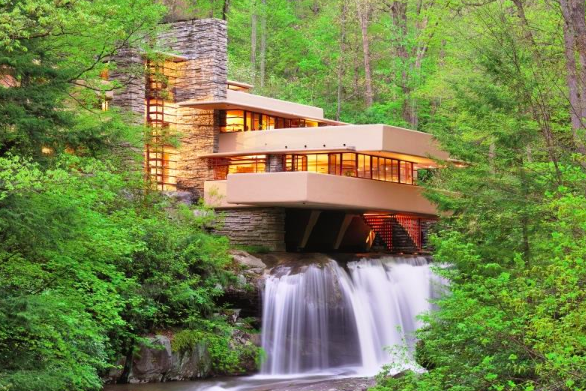

PITTSBURGH (pop 303,000 metropolitan 2,325,000)
Pittsburgh is located in the southwest of the state, at the confluence of the Allegheny, Monongahela, and Ohio rivers. Pittsburgh is known both as “the Steel City” for its more than 300 steel-related businesses and as the “City of Bridges” for its 446 bridges. The city features 30 skyscrapers, two inclined railways, a pre-revolutionary fortification and the Point State Park at the confluence of the rivers. The city developed as a vital link of the Atlantic coast and Midwest, as the mineral-rich Allegheny Mountains made the area coveted by the French and British empires, Virginians, Whiskey Rebels, and Civil War raiders.
Aside from steel, Pittsburgh has led in manufacturing of aluminum, glass, shipbuilding, petroleum, foods, sports, transportation, computing, autos, and electronics. For part of the 20th century, Pittsburgh was behind only New York City and Chicago in corporate headquarters employment; it had the most U.S. stockholders per capita.
Deindustrialization in the 1970s and 80s laid off area blue-collar workers as steel and other heavy industries declined, and thousands of downtown white-collar workers also lost jobs when several Pittsburgh-based companies moved out. The population dropped from a peak of 675,000 in 1950 to 370,000 in 1990. However, this rich industrial history left the area with renowned museums, medical centers, parks, research centers, and a diverse cultural district.
After the deindustrialization of the mid-20th century, Pittsburgh has transformed into a hub for the health care, education, and technology industries. Pittsburgh is a leader in the health care sector as the home to large medical providers such as University of Pittsburgh Medical Center (UPMC). The area is home to 68 colleges and universities, including research and development leaders Carnegie Mellon University and the University of Pittsburgh.
Google, AppleInc., Bosch, Facebook, Uber, Nokia, Autodesk, Amazon, Microsoft and IBM are among 1,600 technology firms generating $20.7 billion in annual Pittsburgh payrolls. The area has served as the long-time federal agency headquarters for cyber defense, software engineering, robotics, energy research and the nuclear navy.
In 2015, Pittsburgh was listed among the “eleven most livable cities in the world”. The Economist‘s Global Liveability Ranking placed Pittsburgh as the most or second-most livable city in the United States in 2005, 2009, 2011, 2012 and 2014.
PPG Place. In the NM “Modern Architecture Buildings”, this consists of six buildings within three city blocks and five and a half acres. Named for its anchor tenant, PPG Industries, who initiated the project for its headquarters, the buildings are all of matching glass design consisting of 19,750 pieces of glass. The complex centers on One PPG Place, a 40-story office building. The complex buildings opened between 1983 and 1984 at a total cost of $200 million ($529.9 million today).
The project was started by PPG Industries (formerly Pittsburgh Plate Glass Company) to serve as the company’s headquarters, after being based in Downtown Pittsburgh since 1895.
The buildings are recognized by their 231 glass spires, with the largest one 82 feet (25 m) tall. Also notable are the surfaces of reflective insulating glass, that served to advertise the project’s founder. The buildings contain over one million square feet of PPG’s Solarban 550 Twindow – 19,750 pieces. The primary building, One PPG Place, is a 40-story tower, with PPG Industries occupying half of the space. The lobby of One PPG is a 50-foot (15 m)-high entrance that features red glass. The building has 21 elevators, each with walls constructed of clear glass panels enclosing fractured glass. The complex also contains a 14-story building, and four 6-story structures.
The design of the building not only made it distinct, but created high energy-efficiency. Heat in the summer is reflected away from the building by the glass, while in winter infrared heat is reflected and contained within the building. The surface walls feature a barrier construction that effectively separates the interior walls from the exterior. The building also collects heat from computer equipment and recycles it throughout the structure.
PPG Place opened an ice skating rink in 2001 that has become a popular seasonal attraction in downtown. A 60-foot (18 m) Christmas tree is in the center of the rink. During the rest of the year, the area with the ice rink is a plaza with tables open to the public and a fountain with 140 water jets and uses 280 underground lights. 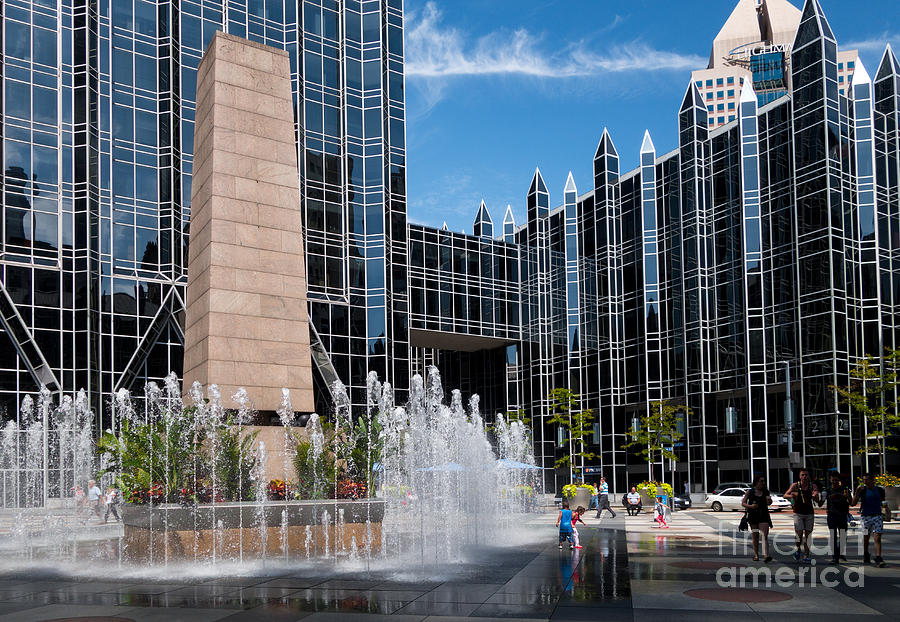 Pittsburgh Public Market. Only about 200m from PPG Place, this lovely open square has 2 rows of trees and an open center.
Pittsburgh Public Market. Only about 200m from PPG Place, this lovely open square has 2 rows of trees and an open center.
Omni William Penn Hotel is a 23 floor (3 underground) hotel in downtown Pittsburgh, Pennsylvania. A variety of luminaries have stayed at the hotel, including John F. Kennedy. The hotel staff innovated Lawrence Welk’s now famous bubble machine, and it was the site of Bob Hope’s marriage proposal in 1934. The hotel has won numerous awards including being named to the “Best of Weddings 2009” list by The Knot.
The hotel also features an award-winning restaurant that dates from 1916, the Terrace Room, featuring among other amenities a wall long mural entitled “The taking of Fort Pitt”. The Terrace Room was voted “Best Hotel Dining” establishment in both 2008 and 2009 by readers of the Pittsburgh City Paper. It is outfitted with numerous furnishings in the Art Deco style.
I returned to northern Pennsylvania after Ohio driving along the south side of Lake Erie.
ERIE (pop 96,500, metro 276,000)
Erie is a city on the south shore of Lake Erie named for the lake and the Native American Erie people who lived in the area until the mid-17th century. Erie is halfway between the cities of Buffalo, New York, and Cleveland, Ohio, and due north of Pittsburgh, Pennsylvania.
Erie’s manufacturing sector remains prominent in the local economy, though healthcare, higher education, technology, service industries, and tourism are emerging as significant economic drivers. Over four million people visit Erie during summer months for recreation at Presque Isle State Park, as well as attractions such as Waldameer Park.
Erie is known as the “Flagship City” because of its status as the home port of Oliver Hazard Perry’s flagship Niagara. Erie in 2012 hosted the Perry 200, a commemoration, celebrating 200 years of peace between Britain, America and Canada following the War of 1812 and Battle of Lake Erie.
Millcreek Mall. This is a typical suburban mall with a large parking lot.
NOMAD MANIA Pennsylvania West (Pittsburgh, Altoona, Erie)
World Heritage Sites: Frank Lloyd Wright Buildings
Villages and Small Towns
Ligonier
House Museums/Plantations
Boalsburg: Columbus Chapel & Boal Mansion Museum
Chalk Hill: Kentuck Knob
Mill Run: Fallingwater
Modern Architecture Buildings: Mill Run: Fallingwater
Railway Museums: Altoona: Railroaders Memorial Museum
The Dark Side: Stoystown: Flight 93 National Memorial
Cities of the Americas
ERIE
Museums: Erie Art Museum
Malls/Department Stores: Millcreek Mall
PITTSBURGH
Airports: Pittsburgh (PIT)
Railway, Metro, Funiculars, Cable Cars
Duquesne and Monongahela Inclines, Pittsburgh
Pittsburgh Light Rail
Museums
Andy Warhol Museum
Carnegie Museums
Mattress Factory
Modern Architecture Buildings: PPG Place
Festivals: Pittsburgh Folk Festival
Zoos: Pittsburgh Zoo & PPG Aquarium
Hospitality Legends: Omni William Penn Hotel
Markets: Pittsburgh Public Market